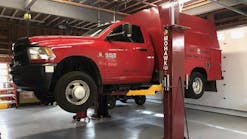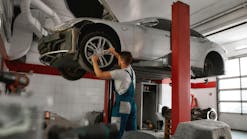We've all seen news stories about a technician that was injured or killed by a car falling off an automotive lift. While it's true that technicians are more likely than the average worker to be injured or killed on the job, as evidenced by higher rates of fatalities and injuries, in no way does this mean that harm has to come your way.
In many cases, injuries result from carelessness and complaceny, which is the human element of the craft you practice every day. Hey, we all know the human race isn't perfect, but there is a magic ingredient you can use to keep the odds in your favor—knowledge of the things that can keep you safe. Oh, sure, there are a host of private and governmental agencies that work to keep you safe, but none of their efforts can help you without using good safety practices. Whether you're a shop owner or technician, there's only one agency truly working in your self-interest—you.
Q: When shopping for a lift, is there something like the "Good Housekeeping Seal" that I can use to make sure a given lift is safe?
A: Yes. Consider this: According to a 2005 report from the Bureau of Labor Statistics, there were 1.5 injury and illness lift-related incidents for every 10,000 full-time automotive repair and maintenance employees. In that same year, eight fatal occupational injuries involving jacks (lifts) occurred. In the following year, the rate for lift-related injury and illness incidents increased to 4.6, while the number of fatal occupational injuries involving jacks rose to 13.
Although this data doesn't give the exact cause of the accidents, you need to make sure you're doing everything in your power to minimize any chances of accidents. With that in mind, make sure that any lifts on your shopping list meet ANSI/ALI ALCTV (current edition), "American National Standard for Automotive Lifts - Safety Requirements for Construction, Testing and Validation". This is the only current standard in North America that governs the design and construction of automotive lifts. This standard addresses the U.S. electrical requirements associated with an automotive lift by incorporating compliance and third-party listing to ANSI UL 201 (current edition), "Safety Standard for Garage Equipment".
For automotive lifts used in the Canadian markets, third-party listing as evidence of compliance with CAN/CSA Std. C22.2 No. 68 is required. Look for a gold certification label from the Automotive Lift Institute (ALI), demonstrating full compliance with applicable U.S. Standards. In Canada, this label also represents full compliance with the applicable Canadian National Standard as shown on the certification label. Meeting these standards requires third-party testing and validation by an OSHA-accredited, Nationally Recognized Testing Laboratory (NRTL) such as Intertek Testing Services (ETL).
Depending on the lift, look for a one of three different certification labels: 1) mechanical compliance only in the U.S. and Canada, 2) mechanical and electrical compliance in the U.S. And Canada, and 3) mechanical and electrical compliance only in the U.S.
Q: So if a lift we're considering has the gold ALI certification label, that's all there is to it, right?
A: Not exactly. In today's world of counterfeit this and that, take it one step further. Check the website of the Automotive Lift Institute at http://www.autolift.org to make sure the lift is listed on the organization's Directory of Certified Lifts. There are lifts on the market with bogus accolades intentionally poised to mislead you, so buyer beware.
Q: We're about ready to place an order for a new lift, but we hesitate because of the seller's sketchy details about installation? Should we be concerned?
A: Yes, any red flag you sense should be treated as a serious issue. Lift safety doesn't begin and end with just the lift itself. A properly installed lift must meet a specific safety standard, ANSI/ALI ALIS (current edition) "Safety Requirements for the Installation and Service of Automotive Lifts." If the company you're dealing with can't ensure installation in compliance with this standard, find another rep or lift.
Q: Does the industry offer any sort of training for lift usage?
A: Yes, the Automotive Lift Institute (ALI) offers a training program called "Lifting It Right" which encourages best practices when using lifts. Use this for every technician in your shop, not just the entry-level techs. You'd be amazed how many experienced technicians have developed bad habits when it comes to using lifts. Don't stop there. Keep a copy of ALI's most recent "Vehicle Lifting Points for Frame Engaging Lifts" near every lift so that the proper lift points are used on each and every vehicle raised on a lift. This habit goes beyond safety; it could also prevent expensive vehicle damage that may result from improper lifting.
Q: Are there some basic essentials we can use for lift safety that we can use in our shop?
A: Yes, the Automotive Lift Institute (ALI) recommends the following safety tips for lift usage. ALI recommends posting them in a spot where they will serve as a constant reminder to lift operators in your shop.
- Inspect your lift daily. Don't use a malfunctioning lift or one with broken or damaged parts. Repairs should be made with original equipment parts.
- Operating controls are designed to close when released. Never block or override them.
- Never overload your lift. Refer to the manufacturer's rated capacity shown on the nameplate affixed to the lift.
- Vehicle positioning and lifting should only be performed by personnel properly trained in the use of that specific lift.
- Never raise a vehicle with anyone inside it. Customers or bystanders should not be allowed in the lifting area during operation.
- Always keep the lift area free of obstructions, grease, oil, trash and other debris.
- Before positioning a vehicle on the lift, position the arms and supports to provide unobstructed clearance. Do not hit or drive over lift arms, adapters, or axle supports. This can damage the lift or vehicle.
- Load the vehicle on the lift carefully. Position the lift supports so they contact the vehicle manufacturer's recommended lifting points. First, raise the lift slowly until it supports the contact vehicle. Then, check the supports for secure contact. Finally, raise the lift to the desired working height. When lifting a vehicle, always make sure the lift locking devices engage.
- Removing and installing some components can cause the vehicle's center of gravity to shift, resulting in unstable lift loading. Refer to the vehicle manufacturer's service manual for recommended procedures when removing and replacing vehicle components.
- Before lowering the lift, be sure tool trays, stands, and so on are removed from underneath vehicle. Release locking devices before lowering the lift.
- Before removing the vehicle from the lift area, move the lift arms and supports out of the way to allow an unobstructed exit.
Q: After a lift is installed, what should we do to keep it in good operating condition?
A: First of all, each and every lift in your shop should be inspected at least once a year, or more often if specified by the manufacturer. The national standard that addresses automotive lift inspection, ANSI/ALI ALOIM (current edition) "Safety Requirements for the Operation, Inspection, and Maintenance of Automotive Lifts," should be followed by the company performing the inspection. The standard encompasses guidance for the owner, employer, and lift service and inspection provider related to required qualifications, training, reporting, and documentation for operators, inspectors, and maintenance personnel. To promote compliance with the standard, sample forms and checklists are included.
Q: Is our shop required to keep a listing of different chemicals we use?
A: Yes, the Occupational Safety and Health Administration (OSHA), requires that each business maintain a collection of Material Safety Data Sheets (MSDS) information on site. You should take a few minutes to review the MSDS information for the products that you use regularly so you're aware of both personal and business-related environmental, health and safety responsibilities. MSDS sheets contain information about products that present health-related exposures, their proper use and the personal protection needed when working with each product. In addition to telling emergency medical staff what to do, an MSDS also advises you on how to protect yourself and how to administer emergency first aid.
Q: We'd like to promote the safe use of hand tools to get our younger techs up to speed quicker and to reduce chances of injuries. Where can we turn to?
A: The Hand Tools Institute (HTI) works to promote hand tool safety and standards in the service industry. As part of their accomplishments, HTI has worked collaboratively with the American National Standards Institute (ANSI) and the American Society of Mechanical Engineers (ASME) to establish and promote no less than fifteen different safety standards related to hand tools. While the standards themselves impact behind-the-scenes elements of hand tool design, what's really helpful to you would be the various products offered by HTI promoting hand tool safety. HTI offers at least ten safety training products ranging from a "Using Hand Tools Safely" brochure to a "Guide to Hand Tools." For more information about HTI and to order training information, go to http://www.hti.org.
Remember, everyone in your shop is a stakeholder when it comes to staying out of harm's way. Incorporate good safety measures in everything you do so they become imbedded in your daily operations. You'll cut the chances of an accident, while improving productivity along the way.


